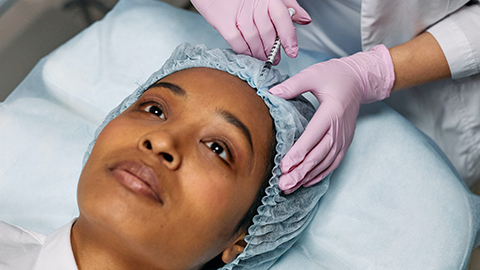Skin lesion removal for Dermatology
Skin lesion removal is a procedure that involves removing or destroying abnormal or unwanted skin growths using specialised methods, such as surgery, cryotherapy, laser surgery, photodynamic surgery, among other techniques.

What is skin lesion removal?
Skin lesion removal is the medical procedure or treatment used to remove abnormal or unwanted growths, such as moles, warts, cysts, or skin cancer, from the skin surface or underlying tissues. Typically skin lesions are removed to improve the appearance of the skin or the area of the body that it is removed from, and are usually analysed to check what the cause of the lesion was.
What are the most common techniques for skin lesion removal?
The most common techniques to remove benign skin lesions include:
Partial removal (shave biopsy) – a lesion that protrudes from the skin is ‘shaved’ off so that the skin is level around. This is often combined with cauterisation which uses heat to seal the skin and stop any bleeding. This technique is used for skin tags and small moles.
Skin excision – full thickness – this technique involves removing a skin lesion in the deeper levels of the skin down to the fatty layer below the skin. A small amount of normal tissue surrounding the lesion may be removed to ensure it is clear of any possible cancer cells (clear margins). This technique is more likely to be used when there is a concern about skin cancer. The area is closed with stitches.
Curettage and electrodesiccation – this procedure involves scraping or scooping out a skin lesion. A technique that uses high frequency electrical current, called electrodesiccation, may be used before or after the procedure. This technique may be used for superficial lesions that do not need a full thickness excision.
Partial removal (shave biopsy) – a lesion that protrudes from the skin is ‘shaved’ off so that the skin is level around. This is often combined with cauterisation which uses heat to seal the skin and stop any bleeding. This technique is used for skin tags and small moles.
Skin excision – full thickness – this technique involves removing a skin lesion in the deeper levels of the skin down to the fatty layer below the skin. A small amount of normal tissue surrounding the lesion may be removed to ensure it is clear of any possible cancer cells (clear margins). This technique is more likely to be used when there is a concern about skin cancer. The area is closed with stitches.
Curettage and electrodesiccation – this procedure involves scraping or scooping out a skin lesion. A technique that uses high frequency electrical current, called electrodesiccation, may be used before or after the procedure. This technique may be used for superficial lesions that do not need a full thickness excision.
When should a skin lesion be removed?
A skin lesion should be considered for removal if it is suspected of being cancerous or malignant. This is done primarily to halt the spread of the skin lesion, and also to take a sample of the skin lesion to be analysed in a laboratory. They may also need to be removed to if they impair any kind of bodily function, due to the positioning, and for cosmetic reasons if they are in a prominent position.
Medical centres with this test:
See all medical centres with this test